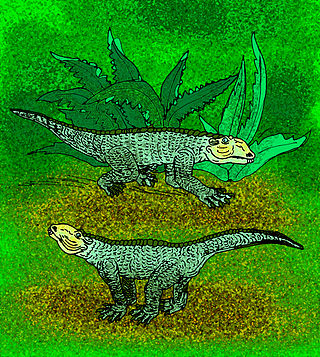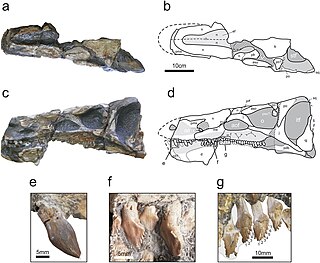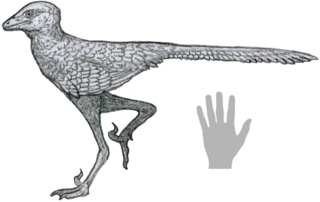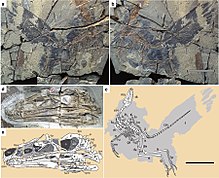
Monolophosaurus is an extinct genus of tetanuran theropod dinosaur from the Middle Jurassic Shishugou Formation in what is now Xinjiang, China. It was named for the single crest on top of its skull. Monolophosaurus was a mid-sized theropod at about 5–5.5 metres (16–18 ft) long and weighed 475 kilograms (1,047 lb).

Sinornithoides is a genus of troodontid theropod dinosaurs containing the single species Sinornithoides youngi. S. youngi lived during the Early Cretaceous. It measured approximately one meter long (3.3 ft). It lived in Inner Mongolia, China, and probably ate invertebrates and other small prey. They lived in what is now Mongolia, which was part of Laurasia.

Sinusonasus is a genus of dinosaurs from the Early Cretaceous Period, recovered from the Yixian Formation. It lived in what is now the Liaoning Province of China. Sinusonasus was a theropod, specifically a troodontid dinosaur.

Jeholosaurus is a genus of neornithischian dinosaur from the Early Cretaceous Period. It is thought to have been a herbivorous small ornithopod.

Chimaerasuchus is an extinct genus of Chinese crocodyliform from the Early Cretaceous Wulong Formation. The four teeth in the very tip of its short snout gave it a "bucktoothed" appearance. Due its multicusped teeth and marked heterodonty, it is believed to have been an herbivore. Chimaerasuchus was originally discovered in the 1960s but not identified as a crocodyliform until 1995, instead thought to possibly be a multituberculate mammal. It is highly unusual, as only two other crocodyliforms have displayed any characteristics resembling its adaptations to herbivory.

Anchiornis is a genus of small, four-winged paravian dinosaurs, with only one known species, the type species Anchiornis huxleyi, named for its similarity to modern birds. The Latin name Anchiornis derives from a Greek word meaning "near bird", and huxleyi refers to Thomas Henry Huxley, a contemporary of Charles Darwin.

Xixiasaurus is a genus of troodontid dinosaur that lived during the Late Cretaceous Period in what is now China. The only known specimen was discovered in Xixia County, Henan Province, in central China, and became the holotype of the new genus and species Xixiasaurus henanensis in 2010. The names refer to the areas of discovery, and can be translated as "Henan Xixia lizard". The specimen consists of an almost complete skull, part of the lower jaw, and teeth, as well as a partial right forelimb.

Geminiraptor is a genus of troodontid theropod dinosaur that lived in North America during the Early Cretaceous period. Geminiraptor was a small, ground-dwelling bipedal carnivorous paravian. The type species of Geminiraptor is G. suarezarum.
Hexing is an extinct genus of basal ornithomimosaur dinosaur known from the Early Cretaceous of northeastern China. It contains a single species, Hexing qingyi.

Jianchangosaurus is a genus of therizinosaurian dinosaur that lived approximately 126 million years ago during the early part of the Cretaceous Period from the Yixian Formation in what is now China. The nearly complete juvenile specimen was missing only the distal tail. Jianchangosaurus was a small, lightly built, bipedal, ground-dwelling herbivore, that could grow up to an estimated 2 m (6.6 ft) long and was 1 m (3.3 ft) high at the hips.
This glossary explains technical terms commonly employed in the description of dinosaur body fossils. Besides dinosaur-specific terms, it covers terms with wider usage, when these are of central importance in the study of dinosaurs or when their discussion in the context of dinosaurs is beneficial. The glossary does not cover ichnological and bone histological terms, nor does it cover measurements.
Panguraptor is a genus of coelophysid theropod dinosaur known from fossils discovered in Lower Jurassic rocks of southern China. The type and only known species is Panguraptor lufengensis. The generic name refers to the deity Pangu but also to the supercontinent Pangaea for which in a geological context the same characters are used: 盘古. Raptor means "seizer", "robber" in Latin. The specific name is a reference to the Lufeng Formation. The holotype specimen was recovered on 12 October 2007 from the Lufeng Formation of Yunnan, which is noted for sauropodomorph fossils. It was described in 2014 by You Hai-Lu and colleagues.

Dracoraptor is a genus of coelophysoid dinosaur that lived during the Hettangian stage of the Early Jurassic Period of what is now Wales dated at 201.3 ± 0.2 million years old.

Isaberrysaura is a genus of stegosaurian ornithischian dinosaur from the Middle Jurassic Los Molles Formation of Patagonia, Argentina. The genus contains a single species, I. mollensis, described by Salgado et al. in 2017 from a single specimen. Although initially classified as a basal neornithischian, subsequent analysis has allied it with the Stegosauria; the morphology of its skull resembles those of other members of the group.

Jianianhualong is a genus of troodontid theropod dinosaur from the Early Cretaceous of China. It contains a single species, Jianianhualong tengi, named in 2017 by Xu Xing and colleagues based on an articulated skeleton preserving feathers. The feathers at the middle of the tail of Jianianhualong are asymmetric, being the first record of asymmetrical feathers among the troodontids. Despite aerodynamic differences from the flight feathers of modern birds, the feathers in the tail vane of Jianianhualong could have functioned in drag reduction whilst the animal was moving. The discovery of Jianianhualong supports the notion that asymmetrical feathers appeared early in the evolutionary history of the Paraves.

Liaoningvenator is a genus of troodontid theropod dinosaur from the Early Cretaceous of China. It contains a single species, L. curriei, named after paleontologist Phillip J. Currie in 2017 by Shen Cai-Zhi and colleagues from an articulated, nearly complete skeleton, one of the most complete troodontid specimens known. Shen and colleagues found indicative traits that placed Liaoningvenator within the Troodontidae. These traits included its numerous, small, and closely packed teeth, as well as the vertebrae towards the end of its tail having shallow grooves in place of neural spines on their top surfaces.

Serikornis is a genus of small, feathered anchiornithid dinosaur from the Upper Jurassic Tiaojishan Formation of Liaoning, China. It is represented by the type species Serikornis sungei.

Anchiornithidae is a family of small paravian dinosaurs. Anchiornithids have been classified at varying positions in the paravian tree, with some scientists classifying them as a distinct family, a basal subfamily of Troodontidae, members of Archaeopterygidae, or an assemblage of dinosaurs that are an evolutionary grade within Avialae or Paraves.

Gnathovorax is a genus of herrerasaurid saurischian dinosaur from the Santa Maria Formation in Rio Grande do Sul, Brazil. The type and only species is Gnathovorax cabreirai, described by Pacheco et al. in 2019.

Polymorphodon is an extinct genus of archosauriform reptile from the Middle Triassic of Germany. The only known species is Polymorphodon adorfi, discovered in Lower Keuper deposits at a quarry in Eschenau, Germany. Polymorphodon is notable for its heterodont dentition, with long and conical premaxillary teeth followed by thin maxillary teeth with large serrations. Maxillary teeth near the back of the mouth are short and leaf-shaped, similar to some living and extinct reptiles with a herbivorous or omnivorous diet. This may suggest that Polymorphodon had some reliance on plants in its diet, a rarity among basal archosauriforms, most of which are carnivores.































